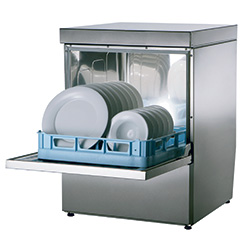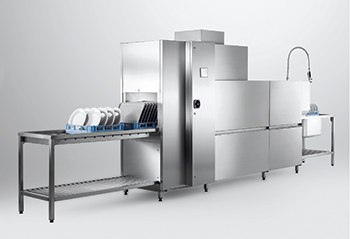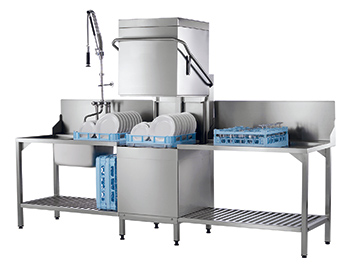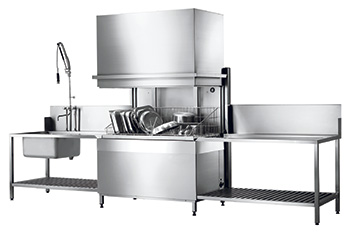While many of us were celebrating the holidays this past season, the U.S Department of Energy (DOE) was hard at work finalizing a variety of new appliance standards, including those for simple water-saving tools like low-flow aerators and prerinse spray valves.
 According to the Environmental Protection Agency, nearly 1 million foodservice operators in the U.S. use approximately 51 billion gallons of water each year, just to rinse dishes with prerinse spray valves. In fact, prerinse spray valves can account for nearly one-third of the water used in the typical commercial kitchen. In response, and beginning in 2019, the new federal standard for prerinse spray valves will reduce to 1.28 gallons per minute from 1.6 gallons per minute and save an estimated $500 over the valve’s life cycle. For chains and operators with multiple valves and kitchens, these savings can add up quickly. Nationwide, the DOE estimates the new standard will save 120 billion gallons of water over the next 30 years.
According to the Environmental Protection Agency, nearly 1 million foodservice operators in the U.S. use approximately 51 billion gallons of water each year, just to rinse dishes with prerinse spray valves. In fact, prerinse spray valves can account for nearly one-third of the water used in the typical commercial kitchen. In response, and beginning in 2019, the new federal standard for prerinse spray valves will reduce to 1.28 gallons per minute from 1.6 gallons per minute and save an estimated $500 over the valve’s life cycle. For chains and operators with multiple valves and kitchens, these savings can add up quickly. Nationwide, the DOE estimates the new standard will save 120 billion gallons of water over the next 30 years.
Many manufacturers have already jumped the gun and reduced their maximum flow rates to this level, so installing one is an easy first step to start saving more water now. But we at FE&S always want to take things one step further, so we caught up with Amin Delagah, the water guru and senior engineer at the PG&E Food Service Technology Center (FSTC) in San Ramon, Calif., to find out about some of the newer, more complex tools and technologies in the water-saving world as more parts of the country continue to face hard droughts and rising utilities costs.
1. Consider replacing outdated dishwashers with newer conveyor and flight-type dishwashers.
 Conveyor dishwashers represent one of the largest consumers of water and energy in a large commercial foodservice operation. The FSTC’s extensive conveyor dishwasher study includes performance metrics from units in the field for the first time ever, and the findings are eye-opening.
Conveyor dishwashers represent one of the largest consumers of water and energy in a large commercial foodservice operation. The FSTC’s extensive conveyor dishwasher study includes performance metrics from units in the field for the first time ever, and the findings are eye-opening.
“We found that the water use for the conventional rack conveyor dishwasher is approximately 700 gallons per hour, and this was reduced by 60 percent when replaced with a high-efficiency dishwasher performing at about 260 gallons per hour,” says Delagah. “What’s great is that real world water savings is way higher than estimated savings using the manufacturers’ rated consumption.”
This first-of-its-kind research project monitored 12 rack conveyors and 6 flight-type conveyors at hotels, institutional foodservice operations and even at the cafés at Google and Facebook over a period of 3 years to examine the complexity of conveyor dishwashers in depth, benchmarking water and energy use of old dishwashers operating in facilities and identifying strategies to sustain the savings potential of high-efficiency machines.
According to the study, the water savings from flight conveyor dishwashers was even greater — a reduction of 75 percent. Water use of the average conventional rack conveyor, at 1,119 gallons per hour of rinse operation, was reduced to 267 gallons for the average high-efficiency unit.
The average cost savings per site, based on average California utility rates was approximately $22,000 per year, and in each case, the cost savings were driven by the substantial reduction in water use.
Some of the savings can be attributed to newer add-ons like security features that prevent the machine from filling up the tank when the drain valves are accidentally left open, sending water flowing down the drain.
Replacing older equipment for these newer technologies, naturally, is a fast, easy way to save water and money. The FSTC’s research showed that old conveyor dishwashers consume two to three times more water than was predicted based on the rated rinse flow and tank volume specifications. But knowing when to replace is another thing.
 “Any machine over 10 or 15 years of age is definitely ready for a change out, but the other signs it’s time to replace the equipment are if their booster heater is not able to keep up with the demands of the dishwasher, or if the temperature of the rinse water starts to decline below 180 degrees F, or when the rinse flow is higher than the original specification,” Delagah says.
“Any machine over 10 or 15 years of age is definitely ready for a change out, but the other signs it’s time to replace the equipment are if their booster heater is not able to keep up with the demands of the dishwasher, or if the temperature of the rinse water starts to decline below 180 degrees F, or when the rinse flow is higher than the original specification,” Delagah says.
Going forward, maintenance and proper operation remain essential to achieve prolonged water savings. Delagah suggests installing utility-grade water meters to monitor the machine over the course of its life. “You can also benchmark the machine for its water use so you know when it’s operating correctly and the staff are operating it correctly,” he says.
The majority of conveyor machines installed in facilities are designed for front-of-the-house wares, such as dishes, glassware and eating utensils, but as more facilities direct their back-of-the-house wares such as pans and trays, they challenge the machines to accommodate large wares that can impact water use, according to the study. “Putting a sheet pan horizontally on a rack can cause the machine to overspray, shooting water from one tank to another which can lead to water waste and even engage the tank to start filling up with fresh water,” says Delagah. “The way you load the dishwasher is very important, and in this case you want a conveyor to be tall or you need specialized sheet pan racks.”
In addition, many machines were found to be oversized relative to the operation because of a potential overemphasis on conveyor speed and rack capacity in the design phase. Without sufficient staff to operate the machines, there is little to be gained with the higher-throughput machines. Attention, consultants: here’s your time to shine.
And, here’s where those more efficient pre-rinse spray valves come into play. While the dishwasher is responsible for the final cleaning and sanitization of the dishes, the work starts at the pre-rinse station, the FSTC’s report states. Using a pre-rinse spray valve at 1.28 gallons per hour instead of 1.6 can save a few extra hundred dollars, as the DOE has pointed out.
2. Investigate new dipper well replacement technology.
 Many coffee shops, ice cream stores and even some restaurants and bars have used the age-old dipper wells that rely on constantly flowing water to flush out potentially harmful microbes and keep equipment and tools clean.
Many coffee shops, ice cream stores and even some restaurants and bars have used the age-old dipper wells that rely on constantly flowing water to flush out potentially harmful microbes and keep equipment and tools clean.
“They are huge water wasters,” says Delagah. “Just by replacing them with the newer models we have found operators could save 90 percent to 95 percent of the intended water use for the dipper well while accomplishing the same goals.”
Here’s how the new technology works: an aerated faucet overhead sprays a powerful stream of water over the spoon, scooper or other utensil when and only when the staff member presses the utensil down on the ceramic head. Then, the utensils can air dry in an adjacent holding compartment and be ready for the next use. Add-ons include a separate faucet that can be used to dispense water for further cleaning as needed, making the holding compartment function more like a sink.
3. Don’t discard the efficiency of newer boilers.
While connectionless or boilerless steamers have always been thought of as the ultimate go-to type when it comes to saving water with this type of equipment, research indicates that newer boiler-based steamer models are actually showing marked improvements in water efficiency.
“The market has evolved, so now there are a few boiler-based models that also significantly reduce water use per hour,” says Delagah, noting older models use about 40 gallons of water per hour while some of the new boiler-based steamers use only 15 gallons per hour or even less — as little as 2 or 3 gallons per hour.
Lower flow rates during the steam-injection process into the steamer cavity along with more sophisticated controls help achieve a reduction in overall water use.
Boiler-based steamers tend to be more popular among operators that perform more on-demand cooking versus batch cooking. “If you are opening the door all the time you want the power of a steam generator model so the equipment will ramp up quickly and do its job,” says Delagah.
Case in point: don’t be intimidated by some of the
more complex models on the market, and try not to rely heavily on old myths about which types of equipment perform better than others. Research proves operators have much more water-saving potential than originally thought — way beyond our trusty aerators and low-flow spray valves.



